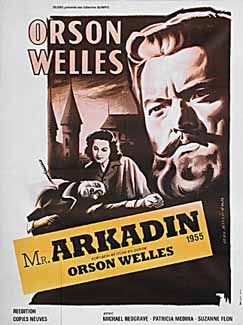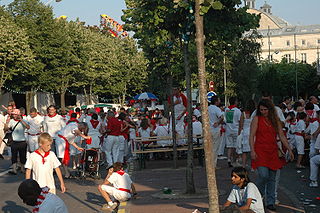Related Research Articles

Jerez de la Frontera or simply Jerez, also cited in old English-language sources as Xeres, is a city and municipality in the province of Cádiz in the autonomous community of Andalusia, Spain. Located in southwestern Iberia, it lies on the Campiña de Jerez, an inland low-land plain crossed by the Guadalete river, midway the Atlantic Ocean, the Guadalquivir river and the western reaches of the Subbaetic System.
Oja Kodar is a Croatian actress, screenwriter and director known as Orson Welles's romantic partner during the later years of his life.

Mr. Arkadin, known in Britain as Confidential Report, is a French-Spanish-Swiss co-production film noir, written and directed by Orson Welles and shot in several Spanish locations, including Costa Brava, Segovia, Valladolid, and Madrid. Filming took place throughout Europe in 1954, and scenes shot outside Spain include locations in London, Munich, Paris, the French Riviera, and at the Château de Chillon in Switzerland.
Don Quixote, fully El ingenioso hidalgo Don Quijote de la Mancha, is a classic novel by Miguel de Cervantes Saavedra, originally published in two parts, in 1605 and 1615.

The seguidilla is an old Castilian folksong and dance form in quick triple time for two people with many regional variations. The music is generally in a major key and often begins on an offbeat.

Orson Welles (1915–1985) was an American director, actor, writer, and producer who is best remembered for his innovative work in radio, theatre and film. He is widely considered one of the greatest and most influential filmmakers of all time.

Arnoldo Foà was an Italian actor, voice actor, theatre director, singer and writer. He appeared in more than 130 films between 1938 and 2014.
Don Quixote is an unfinished film project written, co-produced and directed by Orson Welles. Principal photography took place between 1957 and 1969. Test footage was filmed as early as 1955, second-unit photography was done as late as 1972, and Welles was working on the film intermittently until his death in 1985. The film was eventually edited by Jesús Franco and was released in 1992, to mixed reviews.
Barbara D'Urso is an Italian television presenter, actress and writer.

Paola di Gerfalco, Contessa di Gerfalco, better known by her professional name Paola Mori, was an Italian actress and aristocrat, and the third and last wife of Orson Welles.

Roberto Procaccini • Lobbe is an Italian composer, producer, and keyboard player.

A feria is an annual local festival in Spain and southern France, characterized by bullfights, bull running in the streets, bodegas and bandas. The word festayre means ferias' partiers.
This is a bibliography of books by or about the director and actor Orson Welles.

The Citizen Kane trailer is a four-minute, self-contained, "making of" promotional short film by Orson Welles and the Mercury Theatre, released in 1940 to promote the film Citizen Kane. Unlike other standard theatrical trailers of the era, it did not feature any footage of the actual film itself, but was a wholly original pseudo-documentary piece. It is considered by numerous film scholars such as Simon Callow, Joseph McBride and Jonathan Rosenbaum to be a standalone short film, rather than a conventional "trailer", and to represent an important stage in developing Welles's directorial style.

Marco Giallini is an Italian actor.
This is a list of Italian television related events from 1964.

La Macanita is the artistic name of Tomasa Guerrero Carrasco, a Spanish flamenco singer.
This is a list of Italian television related events from 1968.
This is a list of Italian television related events from 1970.
References
- 1 2 Joseph McBride, What Ever Happened to Orson Welles? A portrait of an independent career (University Press of Kentucky, Lexington, Kentucky, 2006) p.123
- 1 2 3 Jonathan Rosenbaum (ed.), Peter Bogdanovich and Orson Welles, This is Orson Welles (Da Capo Press, New York, 1992 [rev. 1998 ed.]) p.508
- ↑ "Interview with Juan Cobos on Wellesnet" . Retrieved 16 September 2012.
- ↑ Clinton Heylin, Despite the System: Orson Welles versus the Hollywood studios (Canongate, Edinburgh, 2005) p.334